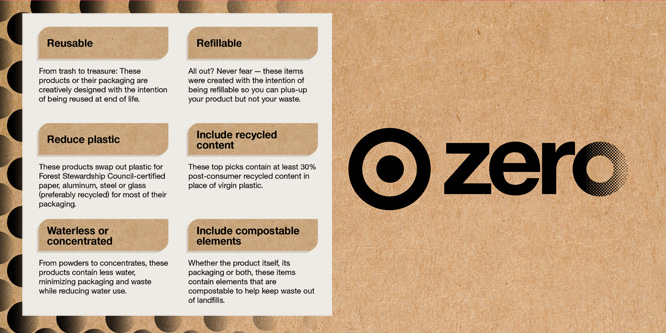Target’s Sustainability: The Good & The Bad
Is Target sustainable? On Karma Wallet, we rate them a 5/16. Here’s why!
June 22, 2023

Target is the 7th largest retailer in the world – pulling in more than $106 billion in sales in 2022. With their scale and size, you might be surprised to hear they have some amazing sustainability goals in place.
From reducing waste to sourcing sustainable products, Target’s sustainability department have implemented various initiatives in recent years to lessen its environmental impact, including the goal of becoming a net zero enterprise by 2040.
With sustainability strategies in place, such as “Target Forward”, the ubiquitous retail and apparel chain has outwardly committed to creating a positive impact on both people and planet. But is this all too good to be true for such a large retailer? Learn why we give Target a rating of 5/16 on Karma Wallet.
The Good
Sustainable Products
Target’s sustainability approach is multifaceted. Outlined in their corporate ESG reports, it features a plan to elevate sustainable brands.
By 2030, Target plans for the leading raw materials (like cotton, forest products, etc) that go into their owned brand products to be 100% recycled, regenerative, or sustainably sourced.
They’re also spending over $2 billion with Black-owned businesses by the end of 2025, and working with partners to sustainably source palm oil, cotton, coffee, and seafood.
In 2022, Target launched its “Target-Zero” initiative with the purpose of helping guests find products in more sustainable packaging. They’ve done this by incorporating reusable and alternative materials into featured packaging.
Additionally, Target has started promoting circular design and closed-loop models, specifically with certain clothing-lines and gift cards.
Renewable Energy
Target is actively working towards their goal of sourcing 100% of operational electricity from renewable energy by 2030.
Not only have they started purchasing agreements for wind power, but they have also installed solar at 560 facility sites in 2021 and continue to add EV chargers at many of their sites.
By 2040, Target plans to have net zero greenhouse gas emissions across their entire business – alongside a 30% absolute reduction in supply chain emissions covering retail goods and services.
For a company of their size, these commitments are meaningful – and Target’s sustainability initiative has detailed plans for each year leading up to 2040, which gives us high confidence they will reach these goals.
Waste Reduction & Elimination
Target has begun efforts to reduce operational waste by partnering with vendors aligned with their commitments to eliminate waste along their supply chain.
They have also committed to a goal of diverting 90% of waste from landfill through reuse, recycling, donation and reduction strategies by 2030.
While they still have a ways to go, they were able to divert 80.7% of operational waste from landfill in 2021, making for a hopeful step towards their 90% goal.
Opportunity & Equity
Target continuously strives to offer fair and competitive wages compared to others in similar industries, adopting minimum wages from $15-24 as of 2022.
Aside from their above-average compensation, Target also prides themselves on their “100% pay equity among women and men, and among BIPOC and white team members”.
In seeking to foster community resilience, Target contributes many financial/ economic resources to underrepresented groups to foster education and support local communities.
The Bad
Transportation Emissions
Due to the scale of its operations, Target’s transportation emissions are a significant contributor to its carbon footprint.
In 2021, Target was found to be one of the biggest maritime polluters, right next to Amazon and Walmart, due to the emissions incurred when importing overseas goods to the U.S.
According to the third-party study, “Target’s dirty shipping produced more CO2 than the entire CO2 output of all 20 of the world’s smallest countries most vulnerable to climate change.”
Luckily, unlike the other retailers mentioned in the study, Target has actually taken its entire supply chain, including maritime endeavors, into the scope of its net zero goals.
Chemical Management
For decades, large retailers have come under fire for distributing products with harmful chemicals, such as flame retardants, phthalates, and carcinogens, many of which can be found in products that you’d least expect, like clothing.
In the early 2000s, Target faced criticism for violations of their products, which contained chemicals that were harmful to the environment. Since 2017, Target has made significant improvements in the name of transparency and enforcing safe chemical management.
Landfill Waste
While Target has made plans to divert as much waste away from landfills through reuse and donations, this has proven to be no easy task.
In 2021, Target reported 210,921 tons of non-hazardous waste being brought to landfills, and 587 tons of hazardous waste sent to landfills.
While this number was a significant increase from the previous year, their attempts to divert waste from landfills and engage in responsible disposal has also increased.
Target’s Sustainability
Taking all this into consideration, we rate Target‘s sustainability and social justice a 5/16 on Karma Wallet, evaluated on 11/16 UN SDGs.
This is much better than the sector average of 2.42 for similar retail and apparel stores. While we have yet to see the results of their commitments to sustainability, we’re hopeful to see what they accomplish along the way. Dive more into their rating below!



















